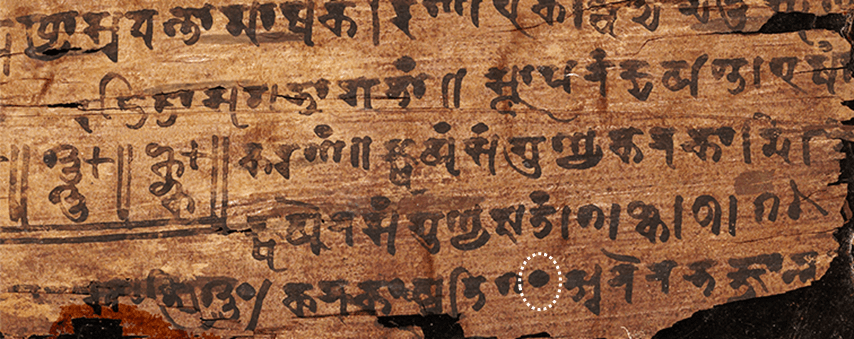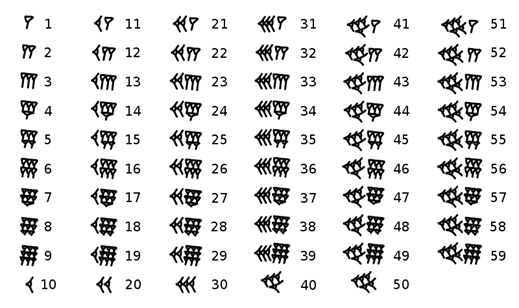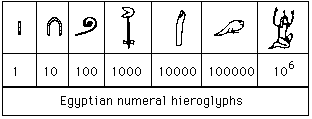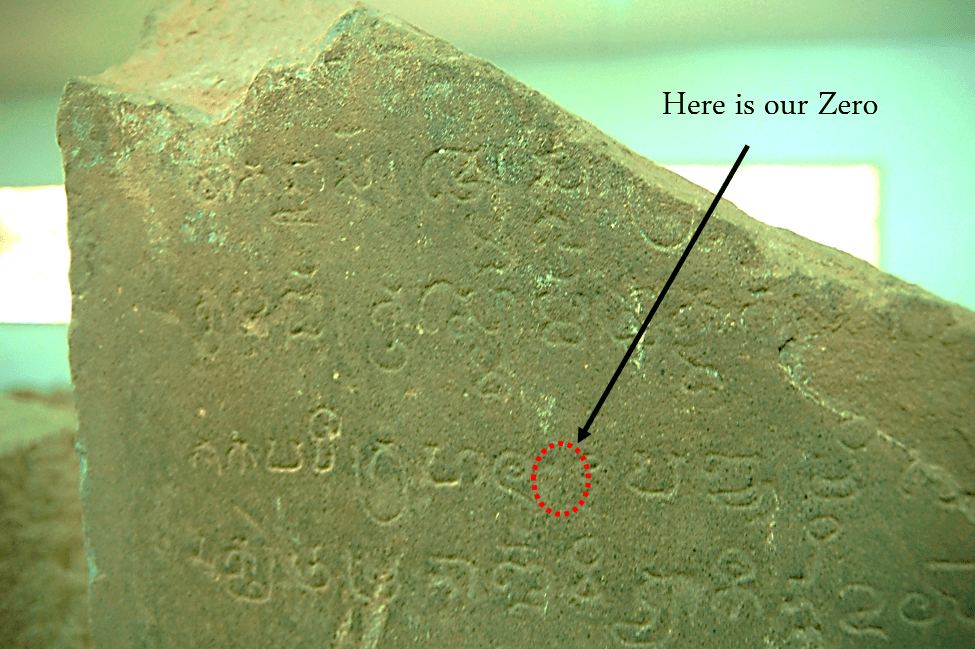There are a number of ways to spend your free time. One easy way is to spend it doing nothing, but even better, it is to read about nothing and the history of nothingness. Therefore, what best to study, other than Zero itself.
To be able to fully appreciate the power of this creation, it would be helpful to understand what Zero means, and how revolutionary this symbol of nothingness has been to humankind. We will take a tour in history to find when Zero was first created. I should acknowledge my contentious use of the word “created” here. I am well aware of the two schools of thought in regard to origin of numbers: Are numbers natural reality, always in existence? Thus, we only discovered them? Or, we invented them in order to describe our reality? This question is perhaps one of the most debated topics in philosophy, with schools such as Plato arguing that number (including zero), exist independent of humans and our existence. Not only numbers, mathematical axioms have also been argued to be natural reality and not created by humans. Mathematician and Cosmologist Roger Penrose, (awarded the 2020 Nobel Prize in Physics for his work on Black Hole), has also argued in favour of this Platonic view. Statements like “There is no largest prime number” he said, are absolute truths and are a reality regardless of our existence. Others believe that numbers, were created by man, i.e., numbers cannot exist without humans. Since I am not here to settle odds, I will let that question linger, as we go in search for one particular number, the ZERO.
If we were to visit the capitals of ancient civilizations, and ask the people living there what the number Zero is, we would end up with a collection of nothingness, pun intended.
There is a reason for us to start from the Ancient Near East, otherwise known as The Great Mesopotamia. It is here, that we have some of the most fascinating literary records of our civilization, such as the oldest written story, the Epic of Gilgamesh, earliest written laws, etc. If we were to visit this ancient civilization at its peak in 600 BC, we will see that the great Mesopotamian Empire partially had the concept of Zero, but not symbolized. It is merely a blank. The Babylonians living in this time, have a very sophisticated numerical and writing system, their writing system is the Cuneiform which in fact has been in use as far back as the Bronze Age up to the Common Era. It is made with stylus imprinted on clay tablets. And it looks like footprint of chicken walking on wet clay. I used to have chickens, and also had pigeons as pets, so I know what their footprints look like. I just didn’t know that those footprints were some serious literature. How foolish of me!
For the Babylonians, numerical symbols start from 1 and end at 59. This is because they operate in base 60. In case you ever wonder why there are 60 seconds in a minutes or 60 minutes is an hour, this is where the answer lies. Interestingly, since they don’t have need for symbol-zero in the sexadecimal system, they only need concept of zero as place holder, and for that, they just leave a gap. And that suffices.
So, the concept of zero for the Babylonians is literally nothing. Therefore, a merchant who wants to mathematically write that they have zero bottle of wine in Mesopotamia in 620 BC, will have to say, “I have wine”.
What if we were to visit the Mayan civilization of Mesoamerica? Say, at its’ peak sometime between 250 AD to 500 AD in modern day Mexico, and we were to ask a Mayan scribe to write numbers for us, it would consist of only three symbol; a dot, a dash and a leaf-like symbol (asking him to draw a leaf might spark some interesting conversation). The representation of some Mayan symbols in today’s Arabic numerals is shown below.
As you’ve noticed, it seems straightforward, dot means 1, dash means 5 and these combinations can give you any number you want. In my company, we use this system in writing certain things sometimes, and it makes me feel very proud to be part of this ancient civilization.
Another thing you might have noticed is that, they had a symbol for Zero (I’ll like to call it the shell-thingy, very millennial of me). So, does that mean this blog ends here since we have found the Zero? Nah!!! We haven’t even begun. (Or like the Babylonian would say: You have idea.)
You see, the Mayans operated in base 20, not base 10, so the entire thig becomes really complicated because the representation of number “20” is not 4 dashes as you might have guesstimated. Instead, the Mayan will write a “dash” followed by a “shell-thingy” to represent “20”. And the shell-thingy is only a place holder (similar to the Babylonians), and not a number in its own right. The numerical 0 as we know it today is both a place holder, and an independent number for counting nothingness. For example, if I write a number like 01, Zero there is basically just a place holder, while in the number 10, Zero here is a number in its own right. Prof. Marcus du Sautoy of University of Oxford regards this invention of modern zero as a number, to be “the most revolutionary moment in Mathematics.”
Something noteworthy here is that, it seems the further back we go in history, the more we notice this tally system for counting. I was fascinated by this and was curious about the earliest counting/arithmetic that we know of. The answer to this will merit the slight detour that we are about to embark. I promise you it will be worth it.
In 1959, a group of archaeologists were carrying out excavations? in boarders of Uganda and Zaire, when they found certain bone of a baboon, the fibula bone to be precise. On this bone was a sharp glass-like material (quartz) that is attached to the end of the bone. When they investigated the bone however, they noticed it had some markings on it, clear stripes which presumably, were done with similar quartz at the tip of the bone. The markings were vertical lines made in very nice patterns and separated into columns. It would suggest, perhaps, that someone was counting his sheep or something.
As at 1960s, scientist dated the bone be roughly 9000 years old. However, recently, a more precise dating was carried out on this bone, and the result was mind-blowing. They found that the bone actually dates back 25,000 years. That is sometime in Upper Paleolithic era, way before Egyptian civilization, way before recorded history!
Looking at the bone even more closely, it appears that the markings were in fact calculations, in base 10 and also base 12. It not only shows knowledge of multiplication, it also shows knowledge of prime numbers. This is fascinating because many mathematicians believed that humans were only able to develop/understand the idea of prime numbers after we came up with concept of division. The concept of division conservatively dates back 10,000 BC, and many have argued that prime numbers were not understood until 500 BC. What then do we make of this bone? And what really was its purpose? Why would you need prime numbers to count your sheep?
Alexander Marshack, and American scholar and Paleolithic archaeologist, studied this bone extensively, and he concluded that the bone might be a kind of lunar calendar that has six months. Other scholars such as mathematician Claudia Zaslavsky, argued to the contrary. She suggested that the owner of the bone was perhaps a woman, who was counting her menstrual cycle. While we might never know how and what the bone was used to calculate, it remains a wonderful artefact of humankind. If you want to see this bone, you can make a special demand to the Royal Institute for Natural Sciences of Belgium in Brussels.
This bone was later called Ishongo bone, named after the people that lived there over 20,000 years BC. Unfortunately, the Ishongo people lived only for a couple of hundred years, before a volcanic eruption came and buried their entire settlement. Thanks to them, we were able to get a glimpse of the second oldest mathematical tool in the world. The second oldest? You might ask, what is the oldest then? Well, Mama Africa is here at your service.
About a decade after the discovery of the Ishongo bone (which was thought to be the oldest mathematical tool then). Excavators were digging in a Cave in Siteki, somewhere between Mozambique and South Africa, and they found a similar fibular bone with 29 clear inscriptions. When dated, the baboon fibula bone was found to be 37,000 years old. It is named after the mountain where it was found, The Lebombo Bone. It is less complicated than the Ishongo bone, thus led to lesser speculation about its objective. With many suggesting it was a simple counting device.
I hope the detour was worth it. Let’s get back to our hunt for Zero.
Since we’re already in Africa, it might be worthwhile to check if the people of the Pharaohs had a number Zero. So, we travel back in ancient Egypt as far as we can possibly go. Let us start from Neolithic period in 40th millennium BC up to 4th millennium BC, which is the beginning of the predynastic Era. We can see that we really don’t have much writings to begin with, we have fragments of ships, cups, woven linen etc., and there is really nothing to make us believe they had numbers or even had writing. However, if we move closer, from 4th millennium to 3100 BC which is vaguely the predynastic era, here we find amulets, early signs of domestication of donkeys, the oldest known board game (Senet) and obviously tombs, so many tombs. We then move to the Dynastic period, the and wonder from Upper Egypt to Lower Egypt in 3100 BC – which is the beginning of the Dynastic period, and sweep over 3000 years of history. Sweeping all the Pharaonic dynasties until we come to 30 BC where the last known ruler of ancient Egypt lived. Here we have a platter of stuff to check for our Zero. Thanks to the decipherment of ancient Egyptian heliographics, we have a pretty good feeling about the writing system used by various Pharaohs.
In ancient Egypt, they had two methods of numbering system, first was the numeral hieroglyphs, which had a dedicated symbol for every number from 1 to 9, and another symbol for multiples of 10. So, in way, they also had a base 10 system. Albeit having no Zero. If one wants to write 99 for example, they will end up carving 18 symbols, and for 9999, one will have to write 36 symbols!
Perhaps they found this garrulous writing system arduous, and this incentivized them to improve the modus operandi, leading to the second numbering system which is the hieratic numerals. This so-called improved numbering system is even more problematic, if we’re being honest. It seems to me they approach numbers like poetry – so vague and whimsy.
While the hieratic system allows for the joining of symbols, so 9999 will have only 4 symbols rather than the 36, the ridiculous part is that it is not a positional system. Meaning, changing the position of 368 to 836 will basically be the same. How dumb! And we wonder why Moses had to leave.
I hope we can agree at this point that the ancient Egyptians didn’t take Mathematics very seriously. So, we have to leave, to somewhere far, anywhere.
I always say this: Whenever you are looking for the right way, go east. Which is obviously just a wordplay of the fact that East is always on the right-hand side when facing the North. But on this particular occasion, it might prove to be a very useful advice. Up until 2017, the oldest Zero was believed to be in the south eastern country of Cambodia, in the city of Angkor. This mysterious Zero is carved on a sandstone. Since its discovery in the 19th century, it has been a fascinating piece of antiquity. This is the K- 127. What is interesting about the K-127 is that it doesn’t need any dating. The zero we are looking for was literally used in a date on the rock. 2 birds, with 1 rock (pun intended).
The language of carving is in Sanskrit and it reads “The Chaka era has reached the year 605 on the fifth day of the waning moon”. Since the Chaka year begins in 78 AD, it meant this Zero was written in 683 AD. It is written in form of a “dot”, but its purpose is exactly like the Zero that we know today. Many believe this dot representation is what later found its way into the Arabic lexicon, because Zero is still represented as a dot in Arabic today. So there goes the history of our beloved Zero. Right?
Hold on, Plot twist: Enter, the Indians!
There has been one manuscript, that has generated so much controversy over the years. This manuscript is the Bakhshali manuscript, found in Bakhshali province in modern Pakistan some 140 years ago. It is a set of parchment with calculations believed to be by merchants. It contains calculations for square, division etc. Due to its fragile nature and importance, it has since been kept away from people in Oxford Museum.
What is most intriguing about the Bakhshali manuscript is that, it has the number Zero, and the shape is a circle – just like we have today. As I mentioned earlier, this manuscript is so very delicate, that for over 100 years, numerous requests to cut a tiny piece of it for carbon dating had been denied. So, archaeologists and mathematicians have resorted to speculation regarding the date of the manuscript. The language of the text would suggest sometime in 6th century (so close competition with the K-217), the contents might suggest even earlier dates, the type of wood used looks similar to other barks that have been dated to be older than K-127, but these are mere speculations and not concrete proof.

In summer of 2017, after enormous pressure, requests and interest from both academia and the public, a section of the manuscript was approved to be carbon-dated. The result was bewildering.
The radiocarbon dating revealed that the Bakhshali manuscript goes back 3 CE. This means couple of hundred years before K-217 stone. This zero was absorbed into the Indian numerals and in fact, the numerals we use today originate from India, but they only came to light after their codification by the polymath Muhammad ibn Musa al-Khwarizmi, who worked in the house of wisdom (bait al-hikmah) during the Abbasid dynasty. He is accredited for the introduction and deciphering of the Arabic numerals to the West. Speaking of the word “decipher”, it is prefixed of the word cipher, which means Zero in Arabic (sifir). The meaning later became “encoding” because the Roman numerals (which by the way, also doesn’t have a Zero) couldn’t capture this number. So, Zero (sifir) came to mean hidden/concealed/encrypted.
I hope you enjoy this wonderful ride and if anything, I hope you don’t take nothing for granted.









Thank you for this wonderful piece of historide in search of one of human most profound ‘inventions’.
It’s worth reading a hundred times.
Can we say zero is an ‘infinite’ or a version of ‘infinity’? Because both nothingness and infinity are beyond human grasp.
LikeLike
What a wonderful mind blowing historide. Traversing the world for zero. “I have time.” But it worth the ride. Thank you!
LikeLiked by 1 person
This is a very beautiful. I like the occasional humour used by the writer.
Can we now agree that the number base is the most beautiful mathematical piece?
LikeLike
This is incredible. Apart from knowing the origin of nothing ,I also learn about how dated African and Asian civilisation is. I really enjoy the ride.
LikeLiked by 1 person
Thank you Farida, I am glad you enjoyed the article
LikeLike
This is quite revealing and in accord with what I have learnt in the educational course ” The history, sociological and physiological basis of science ” . Thanks for doing justice to the subject Dr.
LikeLike
Thank you for the ride, sir. It was cheerful and educating, as well.
Sir, I am a student of writing and I didn’t get the pun in the 3rd paragraph saying: “If we were to visit the ancient city of civilisation…”. Can you pls educate me more. Thank you. May Allah increase you in knowledge.
LikeLike
Hi nice readiing your post
LikeLike
What a fascinating piece of history! What piqued my curiosity, though, is between Ishongo and Lemombo, why the predilection of the ancient humans to use the fibula bone 🦴 in doing their countings? Why not other flatter bones like the scapula, the pelvis or even the skull bone? Anything particular about the fibula bone? This would be worth exploring too.
Thanks for sharing this piece!
LikeLike
zer0 is the start of humanity
LikeLike